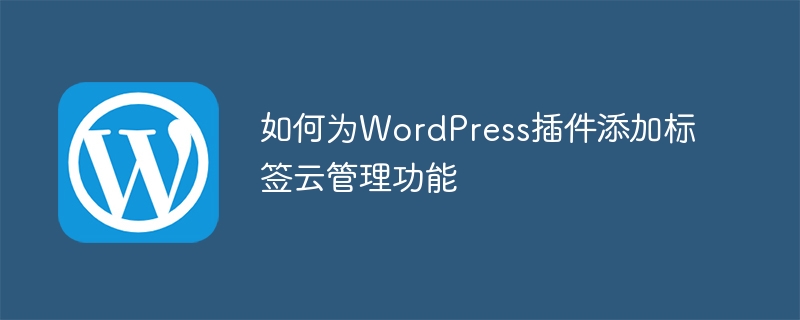

How to add tag cloud management function to WordPress plug-in
Introduction:
WordPress is a powerful and easy-to-use open source content management system. It provides rich extension functions through plug-ins, allowing users to easily customize the website according to their needs. Among them, Tag Cloud is a common function that allows users to display the popularity of different tags in a cloud-like form or arrange them in alphabetical order. This article will introduce you to how to add tag cloud management functionality to WordPress plugins and provide corresponding code examples.
Step 1: Understand the principle of WordPress tag cloud
In WordPress, tags (Tag) are a way to classify articles. Tag cloud arranges different tags according to popularity or alphabetical order, and displays them on website pages according to certain rules. The popularity of a tag is usually measured by counting the number of articles under the tag.
Step 2: Create a tag cloud management page
First, we need to create a page for managing tag clouds. Create a folder called "admin" within your plugins folder, and within that folder create a file called "tag-cloud.php". In this file, we will use WordPress’s admin page structure and add the appropriate forms and code.
<?php
function tag_cloud_page() {
?>
<div class="wrap">
<h1><?php esc_html_e( '标签云管理', 'text-domain' ); ?></h1>
<form method="post" action="<?php echo esc_url( admin_url( 'admin-post.php' ) ); ?>">
<input type="hidden" name="action" value="update_tag_cloud_settings">
<?php wp_nonce_field( 'tag_cloud_settings_action', 'tag_cloud_settings_nonce' ); ?>
<h2><?php esc_html_e( '标签云设置', 'text-domain' ); ?></h2>
<table class="form-table">
<tr>
<th scope="row">
<label for="tag_cloud_min_font_size"><?php esc_html_e( '最小字体大小', 'text-domain' ); ?></label>
</th>
<td>
<input type="number" name="tag_cloud_min_font_size" id="tag_cloud_min_font_size" value="<?php echo esc_attr( get_option( 'tag_cloud_min_font_size', 12 ) ); ?>" class="regular-text" min="10" max="48" step="2">
<p class="description"><?php esc_html_e( '标签云中最小标签的字体大小(单位:像素)', 'text-domain' ); ?></p>
</td>
</tr>
<tr>
<th scope="row">
<label for="tag_cloud_max_font_size"><?php esc_html_e( '最大字体大小', 'text-domain' ); ?></label>
</th>
<td>
<input type="number" name="tag_cloud_max_font_size" id="tag_cloud_max_font_size" value="<?php echo esc_attr( get_option( 'tag_cloud_max_font_size', 24 ) ); ?>" class="regular-text" min="24" max="72" step="2">
<p class="description"><?php esc_html_e( '标签云中最大标签的字体大小(单位:像素)', 'text-domain' ); ?></p>
</td>
</tr>
</table>
<?php submit_button(); ?>
</form>
</div>
<?php
}Step 3: Process the settings save operation
Next, we need to process the submission operation of the tag cloud management page form and save the settings to the database. In your plugin main file, add the following code:
<?php
function save_tag_cloud_settings(){
if ( ! current_user_can( 'manage_options' ) ) {
wp_die( esc_html__( '你没有权限进行此操作!', 'text-domain' ) );
}
check_admin_referer( 'tag_cloud_settings_action', 'tag_cloud_settings_nonce' );
$min_font_size = isset( $_POST['tag_cloud_min_font_size'] ) ? intval( $_POST['tag_cloud_min_font_size'] ) : 12;
$max_font_size = isset( $_POST['tag_cloud_max_font_size'] ) ? intval( $_POST['tag_cloud_max_font_size'] ) : 24;
update_option( 'tag_cloud_min_font_size', $min_font_size );
update_option( 'tag_cloud_max_font_size', $max_font_size );
wp_redirect( add_query_arg( 'message', '1', admin_url( 'admin.php?page=tag-cloud' ) ) );
exit;
}
add_action( 'admin_post_update_tag_cloud_settings', 'save_tag_cloud_settings' );Step 4: Add the menu link to the admin page
Finally, we need to add the link to the tag cloud admin page to the WordPress admin menu . In your plug-in main file, add the following code:
<?php
function add_tag_cloud_management_menu() {
add_submenu_page(
'options-general.php',
'标签云管理',
'标签云管理',
'manage_options',
'tag-cloud',
'tag_cloud_page'
);
}
add_action( 'admin_menu', 'add_tag_cloud_management_menu' );Conclusion:
Through the above steps, we have successfully added the tag cloud management function. You can adjust the minimum and maximum font size of the tag cloud according to your needs and apply it to your WordPress plugin. I hope this article can be helpful to your development work!
The above is the detailed content of How to add tag cloud management functionality to WordPress plugin. For more information, please follow other related articles on the PHP Chinese website!